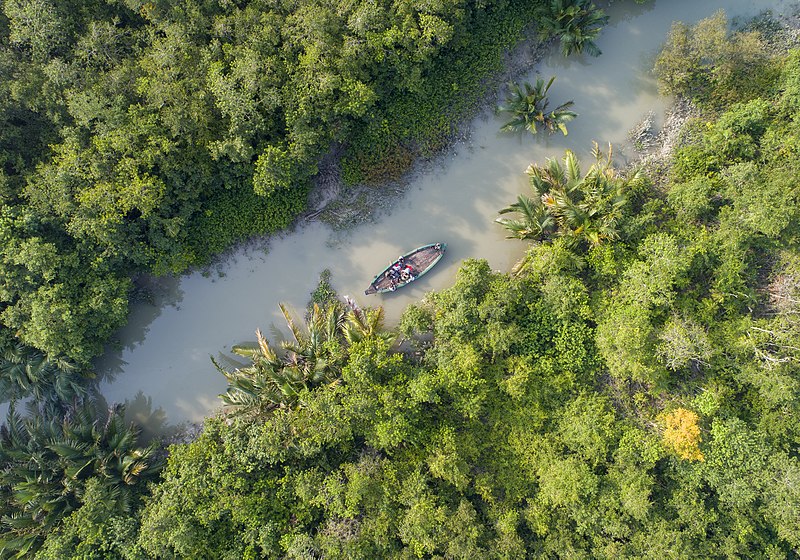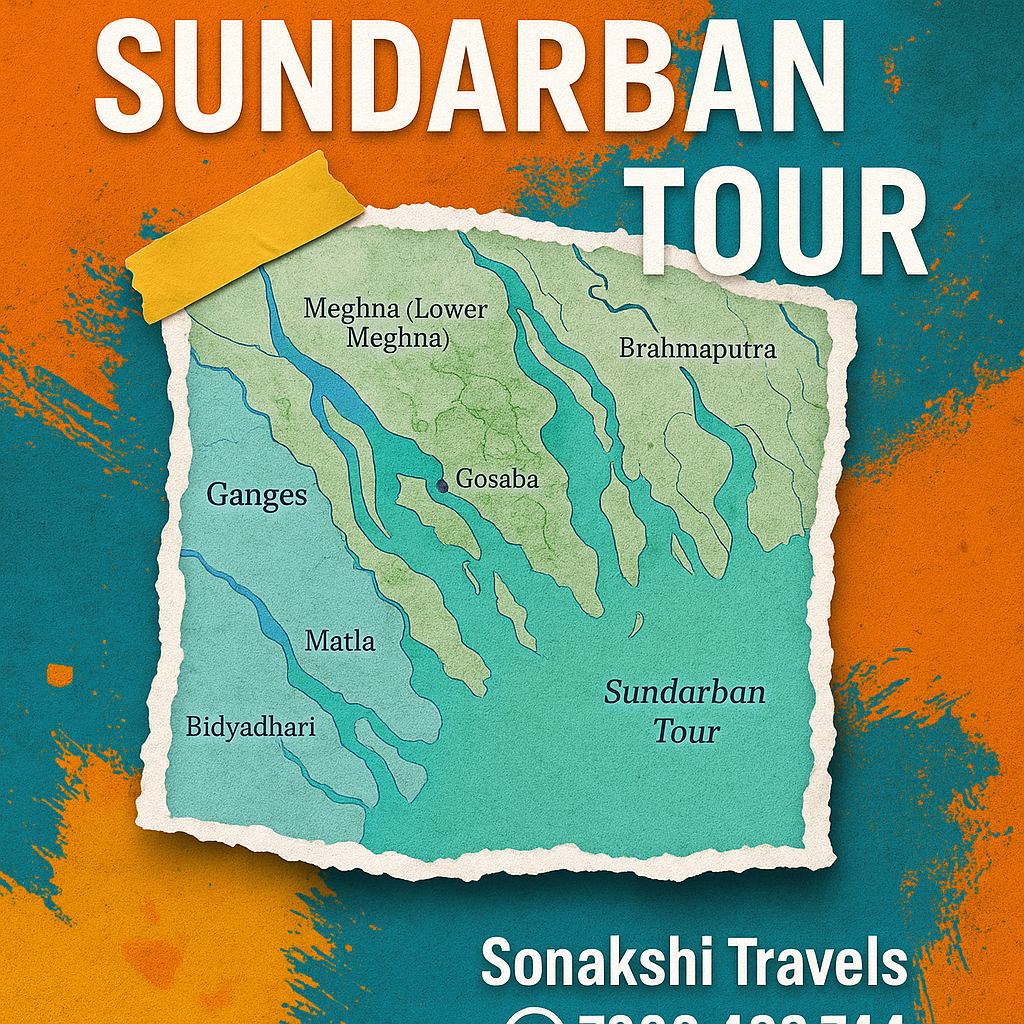Rivers in Sundarban – The Liquid Highways of a Living Forest

The Sundarban is a place where land and water dance in an endless embrace. Here, rivers are not mere geographical features — they are lifelines, storytellers, and architects of one of the world’s most extraordinary landscapes. This vast mangrove delta, recognized as a UNESCO World Heritage Site, thrives because of its intricate web of waterways.
When you set out on a Sundarban Tour, you’re not just entering a forest — you’re sailing into the veins of a living organism. Each tide, each bend in the river, and each mudflat reveal how water shapes life here.
A Delta Born of Giants – The Ganges, Brahmaputra, and Meghna

At the heart of the Sundarbans’ creation is the mighty confluence of three great rivers: the Ganges, the Brahmaputra, and the Meghna. Their meeting point creates the Ganges–Brahmaputra–Meghna delta, the largest in the world.
Ganges (2,510 km)
Flowing from the icy Himalayas to the warm waters of the Bay of Bengal, the Ganges is the spiritual and ecological lifeline of northern India. In the Sundarban context, it delivers freshwater, fertile silt, and nutrients that nourish the mangroves.
Brahmaputra (2,900 km)
Originating as the Yarlung Tsangpo in Tibet, this river takes a dramatic turn into India and Bangladesh, where it becomes the Jamuna before merging with the Ganges. It carries one of the world’s highest sediment loads, building and reshaping the delta’s islands.
Meghna (~264 km lower course)
Where the Padma (Ganges) and Jamuna (Brahmaputra) unite, the Meghna carries their combined waters to the sea. In its lower reaches, it’s a deep, fast estuary, famous for its powerful tidal bores — an awe-inspiring sight for those lucky enough to witness it during a Sundarban Trip.
Gosaba – The Gateway Island
No discussion of the Sundarbans is complete without mentioning Gosaba, the last inhabited island before the forest’s core zone. At 13 feet above sea level, it’s a hub of local life with schools, markets, and a panchayat system, yet it remains your last connection to civilization before venturing deep into mangrove territory.
For travelers, Gosaba often marks the official start of a Sundarban Tour Package. From here, motor launches and smaller boats take you into the heart of the waterways.
Tides that Rule the Land
The Sundarban rivers experience a dramatic tidal phenomenon twice daily. High tides raise water levels by 6–10 feet, flooding creeks and channels. Low tides reveal vast mudflats, exposing the tangled roots of mangroves.
This tidal rhythm shapes everything:
-
It dictates fishing schedules.
-
It controls the movement of wildlife.
-
It reshapes islands and riverbanks.
When you’re on a Sundarban Trip, you quickly realize that the forest’s pulse beats to the rhythm of the tide.
The Lesser-Known Rivers and Their Stories
While the Ganges, Brahmaputra, and Meghna dominate the headlines, the Sundarbans’ unique beauty lies in its network of smaller rivers and distributaries. Each has its own character and role in the ecosystem.
Matla River – The Salty Sentinel
-
Length: More than 200 km (tidal stretch ~99 km)
-
Nature: A tidal estuarine river forming the western boundary of the Indian Sundarbans.
The Matla is notorious for its high salinity and strong tides. Its banks are dotted with fishing villages, and it serves as the main navigational route for many Sundarban-bound boats. It’s also the river that separates Canning — the common entry point for tourists — from the forested islands.
For travelers on a Sundarban Tour, the Matla often provides the first mesmerizing view of endless water merging with the mangroves.
Bidyadhari River – The Forgotten Artery
-
Length: Tidal influence ~95 km
-
Nature: Once a major freshwater river, now largely cut off from the Ganges, carrying mostly brackish water.
The Bidyadhari’s decline as a navigational route mirrors changes in delta hydrology. Today, it still connects to the Raimangal and serves as an important drainage and fishing channel.
Exploring its quieter stretches on a Sundarban Trip gives you a sense of isolation that’s rare in the busier main channels.
Hogla River – The Hidden Passage
-
Length: 37.2 km project stretch (NW-97)
-
Nature: A tidal distributary within the Sundarban network.
The Hogla is less visited by tourists, making it perfect for those seeking exclusivity. Its banks are lined with pristine mangrove stands, and birdwatchers often find it a rewarding route.
Life Along the Rivers
The rivers are more than transport routes — they are sources of life for both humans and wildlife.
For the People
-
Fishing: Hilsa, prawns, and crabs form the backbone of the local economy.
-
Transport: Boats ferry people, goods, and even schoolchildren.
-
Trade: Markets on Gosaba and other islands rely on river routes for supplies.
For the Wildlife
-
Habitat: Rivers provide fresh and brackish water zones that sustain diverse species.
-
Feeding grounds: Low-tide mudflats attract wading birds; creeks shelter juvenile fish.
-
Migration routes: Aquatic species move with the tides and seasons.
Cultural Landmarks on the Rivers
A Sundarban Tour is as much about people as it is about nature. Riverside villages like Widow Village tell stories of courage, where families have endured tiger attacks yet continue to live and work near the forest.
Night Magic – Phytoplankton Glow
One of the Sundarbans’ most enchanting experiences is the sight of bioluminescent phytoplankton. On a dark new moon night, the water comes alive with tiny blue-green sparks when disturbed — a natural light show you can witness on a guided night safari.
Why the Rivers Make a Sundarban Tour Unique
Most wildlife sanctuaries are explored on foot or by jeep. In the Sundarbans, your safari is on water. The boat is your moving viewpoint, the river your trail, and each tide brings a new surprise.
From spotting saltwater crocodiles basking on mudbanks to catching sight of a white-bellied sea eagle soaring above, the experience is unmatched.
Tips for a River-Centric Sundarban Trip
-
Choose your season: Winter offers pleasant weather; monsoon brings lush beauty.
-
Select an experienced guide: They know the best channels for wildlife sightings.
-
Plan for the tides: High tide is great for entering narrow creeks; low tide reveals more birdlife.
-
Stay eco-conscious: Respect the fragile ecosystem — no littering, no noise pollution.
The Emotional Pull of the Sundarban Rivers
Every Sundarban Tour Package is different, but the rivers leave the same mark on every traveler — a deep sense of connection to something timeless. The ebb and flow of the tide mirror the rhythms of life itself.
When you return, you’ll carry memories of golden sunsets over the Matla, quiet mornings on the Bidyadhari, and perhaps the thrill of seeing a tiger’s pugmark on a riverbank.
You may like to read these below links :
Sundarban Tour Package: The River, The Sky, and You
Where the River Kisses the Forest, a Sundarban Tour Begins Your Legacy
From River to Plate: A Culinary Voyage at Sundarban Hilsa Festival 2025
Exclusive River Cruises in Sundarban Private Tour
Plan Your Journey
📞 For bookings and customized Sundarban Tours: +91 7980469744
🌐 Explore more: